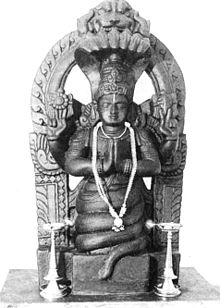
Back Yoga Sutra van Patanjali Afrikaans Yogasutra ALS يوغا سوترا Arabic পতঞ্জলিৰ যোগসূত্ৰ Assamese Йога сутра Bulgarian पतंजलि योग सूत्र Bihari পতঞ্জলির যোগসূত্র Bengali/Bangla Ioga sutra Catalan Pataňdžaliho jógasútra Czech Swtrâu Ioga Patanjali Welsh

| Part of a series on |
| Hindu scriptures and texts |
|---|
 |
| Related Hindu texts |
| Part of a series on | |
| Hindu philosophy | |
|---|---|
 | |
| Orthodox | |
|
|
|
| Heterodox | |
|
|
|

The Yoga Sutras of Patañjali (IAST: Patañjali yoga-sūtra) is a compilation "from a variety of sources"[1] of Sanskrit sutras (aphorisms) on the practice of yoga – 195 sutras (according to Vyāsa and Krishnamacharya) and 196 sutras (according to others, including BKS Iyengar). The Yoga Sutras were compiled in India in the early centuries CE by the sage Patanjali, who collected and organized knowledge about yoga from Samkhya, Buddhism, and older Yoga traditions,[2][3][4][5] and possibly another compiler who may have added the fourth chapter.[a] He may also be the author of the Yogabhashya, a commentary on the Yoga Sutras, traditionally attributed to the legendary Vedic sage Vyasa,[6] but possibly forming a joint work of Patanjali called the Pātañjalayogaśāstra.[5]
The Yoga Sutras draw from three distinct traditions from the 2nd century BCE to the 1st century CE, namely Samkhya, Buddhism traditions, and "various older ascetic and religious strands of speculation."[7] The Yoga Sutras built on Samkhya notions of purusha and prakriti, and is often seen as complementary to it. It is closely related to Buddhism, incorporating some of its terminology.[b] While there is "an apparent lack of unity and coherence,"[8] according to Larson there is a straightforward unity to the text, which focuses on "one-pointed awareness" (ekagrata) and "content-free awareness" (nirvikalpa samadhi); the means to acquire these, namely kriya yoga ("action yoga") and ashtanga yoga (eight-limb yoga); the results acquired from the attainment of these levels of awareness; and the final goal of yoga, namely kaivalya and liberation.[9]
The Yoga Sutras is best known for its sutras on ashtanga yoga, eight elements of practice culminating in samadhi. The eight elements, known as limbs, are yama (abstinences), niyama (observances), asana (yoga posture), pranayama (breath control), pratyahara (withdrawal of the senses), dharana (concentration of the mind), dhyana (meditation) and samadhi (absorption or stillness). When the mind is stilled (vritti nirodha) kaivalya ("isolation") can be attained, the discenrment of purusha (pure consciousness, self, the witness-consciousness) as distinct from prakriti (nature, the cognitive apparatus and the instincts).
The contemporary Yoga tradition holds the Yoga Sutras of Patañjali to be one of the foundational texts of classical Yoga philosophy.[10][11] However, the appropriation – and misappropriation – of the Yoga Sutras and its influence on later systematizations of yoga has been questioned by David Gordon White,[12] who argues that the text fell into relative obscurity for nearly 700 years from the 12th to 19th century, and made a comeback in the late 19th century due to the efforts of Swami Vivekananda, the Theosophical Society and others. It gained prominence as a classic in the 20th century.[12]
- ^ Larson 2008, p. 32.
- ^ Larson 2008, p. 44-45.
- ^ Feuerstein 1978, p. 108.
- ^ Tola, Dragonetti & Prithipaul 1987, p. x.
- ^ a b Wujastyk 2011, p. 33.
- ^ Bryant 2009, p. Introduction.
- ^ Larson 2008, p. 43–44.
- ^ Larson 2008, p. 32-33.
- ^ Larson 2008, p. 66-67.
- ^ Whicher 1998, p. 49.
- ^ Stuart Sarbacker (2011), Yoga Powers (Editor: Knut A. Jacobsen), Brill, ISBN 978-9004212145, p. 195.
- ^ a b White 2014, p. xvi–xvii.
Cite error: There are <ref group=lower-alpha> tags or {{efn}} templates on this page, but the references will not show without a {{reflist|group=lower-alpha}} template or {{notelist}} template (see the help page).